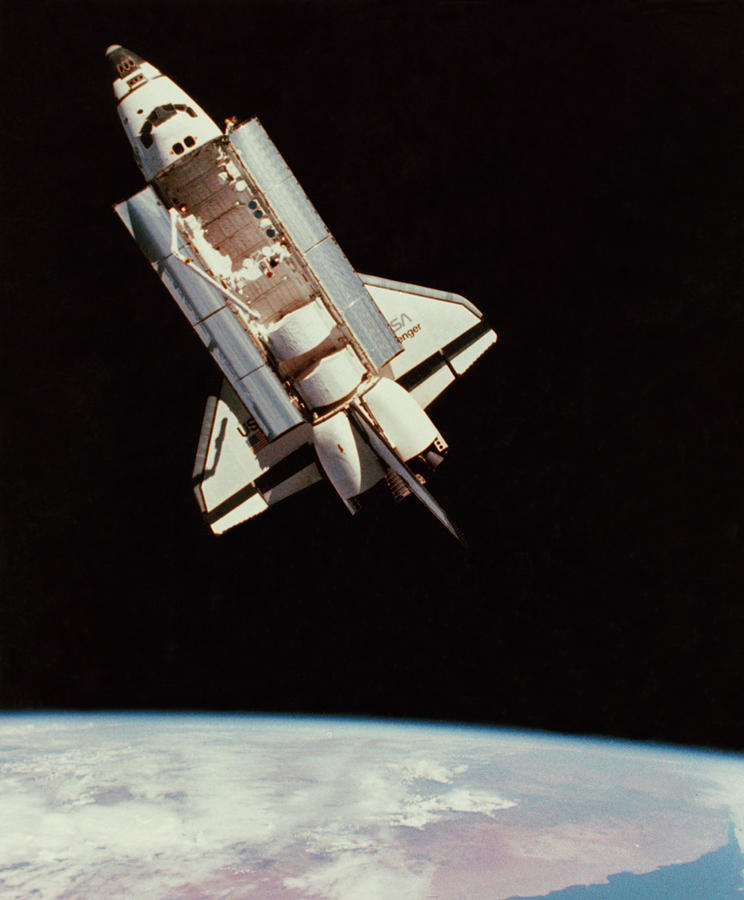
Space Shuttle components include the Orbiter Vehicle (OV) with three clustered Rocketdyne RS-25 main engines, a pair of recoverable solid rocket boosters (SRBs), and the expendable external tank (ET) containing liquid hydrogen and liquid oxygen. The Space Shuttle fleet's total mission time was 1,323 days. Operational missions launched numerous satellites, interplanetary probes, and the Hubble Space Telescope (HST), conducted science experiments in orbit, participated in the Shuttle- Mir program with Russia, and participated in construction and servicing of the International Space Station (ISS). They launched from the Kennedy Space Center (KSC) in Florida. Five complete Space Shuttle orbiter vehicles were built and flown on a total of 135 missions from 1981 to 2011. The first ( STS-1) of four orbital test flights occurred in 1981, leading to operational flights ( STS-5) beginning in 1982. Its official program name was Space Transportation System (STS), taken from a 1969 plan for a system of reusable spacecraft where it was the only item funded for development. National Aeronautics and Space Administration (NASA) as part of the Space Shuttle program. The Space Shuttle is a retired, partially reusable low Earth orbital spacecraft system operated from 1981 to 2011 by the U.S. If you see any problems with this tool, or any of our interactive tools, please send an email to.

To find out when and where you can see the International Space Station in your sky. The space station occupies an orbit roughly 250 miles (400 km) high, whose steep 52° inclination with respect to the equator causes it to pass over virtually all of Earth's populated areas. An interesting collection of images that show changes in the configuration of the space station is on NASA's Human Spaceflight website. From these modest beginnings, the ISS has continued to grow. laboratory module (Destiny), a large array of solar panels, and the Canada2 mobile robotic arm were added in 2001. The addition of two more core modules, Unity and Zvezda ("Star"), paved the way for the arrival of the first crew in November 2000. The International Space StationĬonstruction of the ISS began on November 20, 1998, with the launch of the Russian-built module called Zarya ("Dawn"). Sometimes an appearance or disappearance occurs well up in the sky when the satellite emerges into sunlight or slips into Earth's shadow, respectively. Weather permitting, you should see a slowly and steadily moving "star." The "Departure" entries indicate where the spacecraft will be when it vanishes from sight. To see the spacecraft, look in the direction indicated by "Approach" at the given time. elevation" is how high the satellite will get above your horizon (90° is overhead). "Duration" indicates the length of each sighting in minutes. When you look at the results, "Local Time" is the instant the satellite first becomes visible and is listed for your time zone. The gray oval shows where the satellite is presently above the horizon.
#Nasa space shuttle viewing plus
The current position of the selected spacecraft is shown, plus its ground track over the next hour at 5-minute intervals. This program will also show you in real time where the satellites are over Earth. To view passes of the International Space Station or Hubble Space Telescope, select ISS or HST from the satellite dropdown menu.

You can even save your observing location for use at a later time. Select your city (or enter your latitude and longitude) and time zone and it will calculate potential passes for the next three days. You can see exactly when three of bright satellites will be visible from your location using our Satellite Tracker.
#Nasa space shuttle viewing how to
Instructions: How to Use S&T's Satellite Tracker Predict when and where to view the International Space Station and the Hubble Space Telescope using S&T's Satellite Tracker. The Hubble Space Telescope, though more difficult to see, has taken some of the most iconic images we have of the cosmos. It's brighter than Jupiter and even rivals brilliant Venus as it creeps across the sky after dusk or before dawn.īut while ISS is the brightest humanmade object orbiting our planet, others rival it for personal significance. The brightest artificial satellite in the sky is the International Space Station (ISS) - which makes sense, because it's also the biggest. Launch our Satellite Tracker! The International Space Station, nearing its final length of 250 feet, looks impressive in this image taken by a departing Space Shuttle crew in June 2007.


 0 kommentar(er)
0 kommentar(er)
